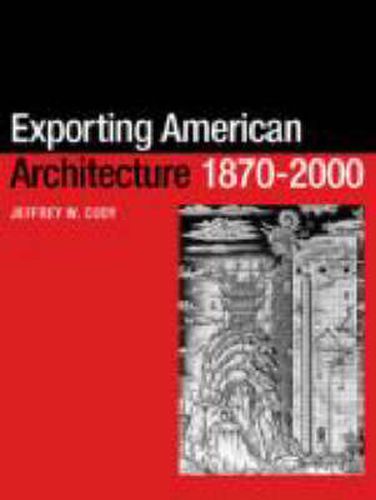Readings Newsletter
Become a Readings Member to make your shopping experience even easier.
Sign in or sign up for free!
You’re not far away from qualifying for FREE standard shipping within Australia
You’ve qualified for FREE standard shipping within Australia
The cart is loading…






The export of American architecture began in the nineteenth century as a disjointed set of personal adventures and commercial initiatives. It continues today alongside the transfer of other aspects of American life and culture to most regions of the world. Jeffrey Cody explains how, why and where American architects, planners, building contractors and other actors have marketed American architecture overseas. In so doing he provides a historical perspective on the diffusion of American building technologies, architectural standards, construction methods and planning paradigms. Using previously undocumented examples and illustrations, he shows how steel-frame manufacturers shipped their products abroad enabling the erection of American-style skyscrapers worldwide by 1900 and how this phase was followed by similar initiatives by companies manufacturing concrete components. He describes the activities of American architects and construction companies between the two world wars, a period when some projects were merely speculative ventures, while others were conscious efforts to disseminate the ideals of ‘the American city’. In exploring the second half of the twentieth century, Cody demonstrates the role of the Marshall Plan, other US government aid programmes and private investments in the further diffusion of American architecture and urbanism worldwide. This influence intensified from the 1970s onwards when American attention turned first to the oil-rich Middle East and then to the Asian Pacific region. He concludes that transplanting American architecture into a non-American place is neither particularly easy nor necessarily sustainable, but if US architects are to export their buildings and design-related ideas to another place they must be more sensitive to the cultural integrity of that place.
$9.00 standard shipping within Australia
FREE standard shipping within Australia for orders over $100.00
Express & International shipping calculated at checkout
The export of American architecture began in the nineteenth century as a disjointed set of personal adventures and commercial initiatives. It continues today alongside the transfer of other aspects of American life and culture to most regions of the world. Jeffrey Cody explains how, why and where American architects, planners, building contractors and other actors have marketed American architecture overseas. In so doing he provides a historical perspective on the diffusion of American building technologies, architectural standards, construction methods and planning paradigms. Using previously undocumented examples and illustrations, he shows how steel-frame manufacturers shipped their products abroad enabling the erection of American-style skyscrapers worldwide by 1900 and how this phase was followed by similar initiatives by companies manufacturing concrete components. He describes the activities of American architects and construction companies between the two world wars, a period when some projects were merely speculative ventures, while others were conscious efforts to disseminate the ideals of ‘the American city’. In exploring the second half of the twentieth century, Cody demonstrates the role of the Marshall Plan, other US government aid programmes and private investments in the further diffusion of American architecture and urbanism worldwide. This influence intensified from the 1970s onwards when American attention turned first to the oil-rich Middle East and then to the Asian Pacific region. He concludes that transplanting American architecture into a non-American place is neither particularly easy nor necessarily sustainable, but if US architects are to export their buildings and design-related ideas to another place they must be more sensitive to the cultural integrity of that place.